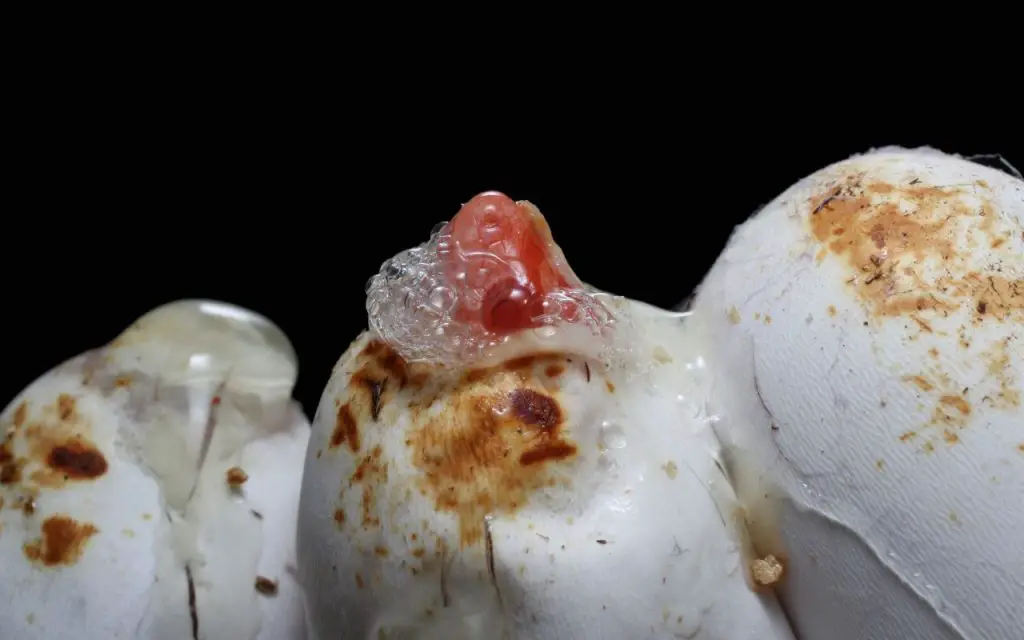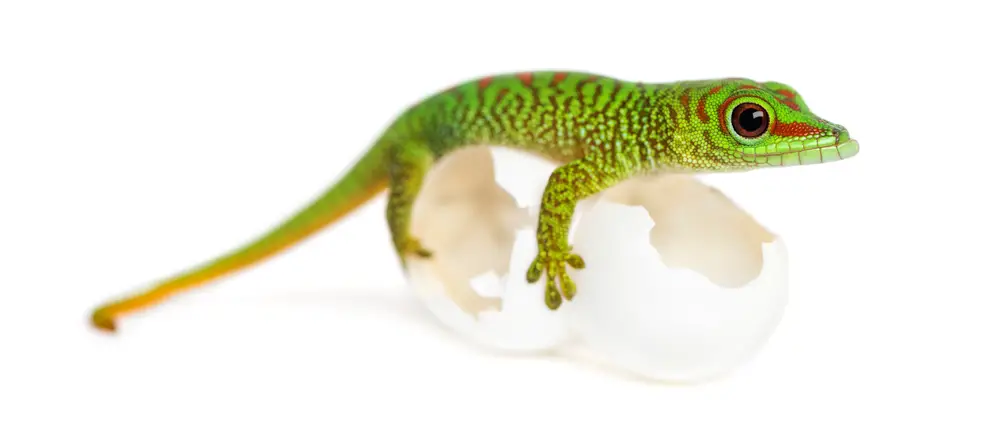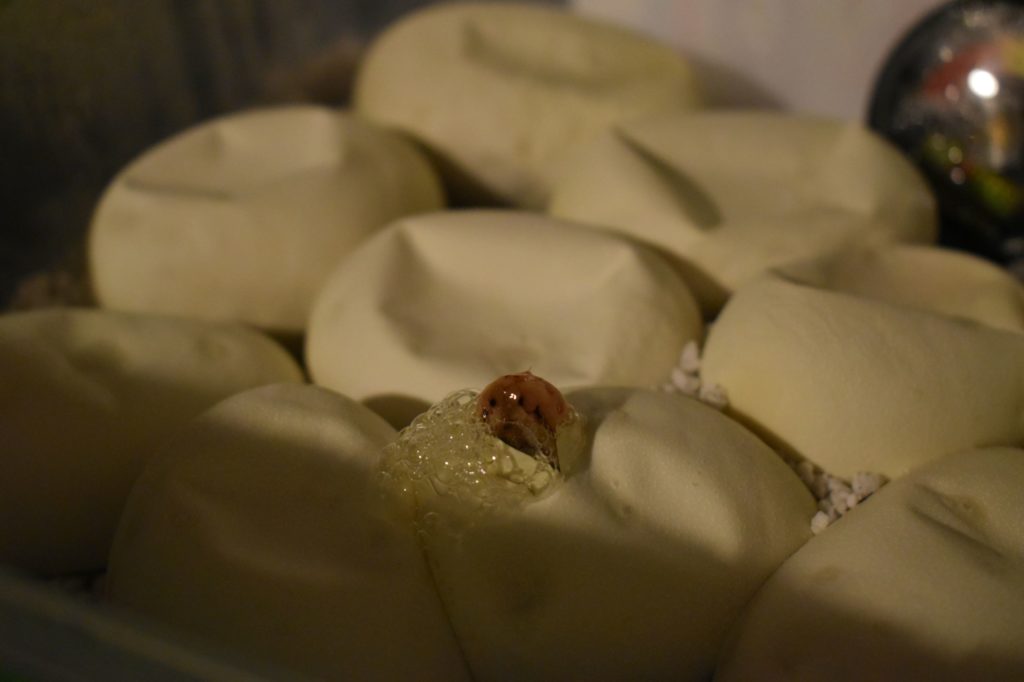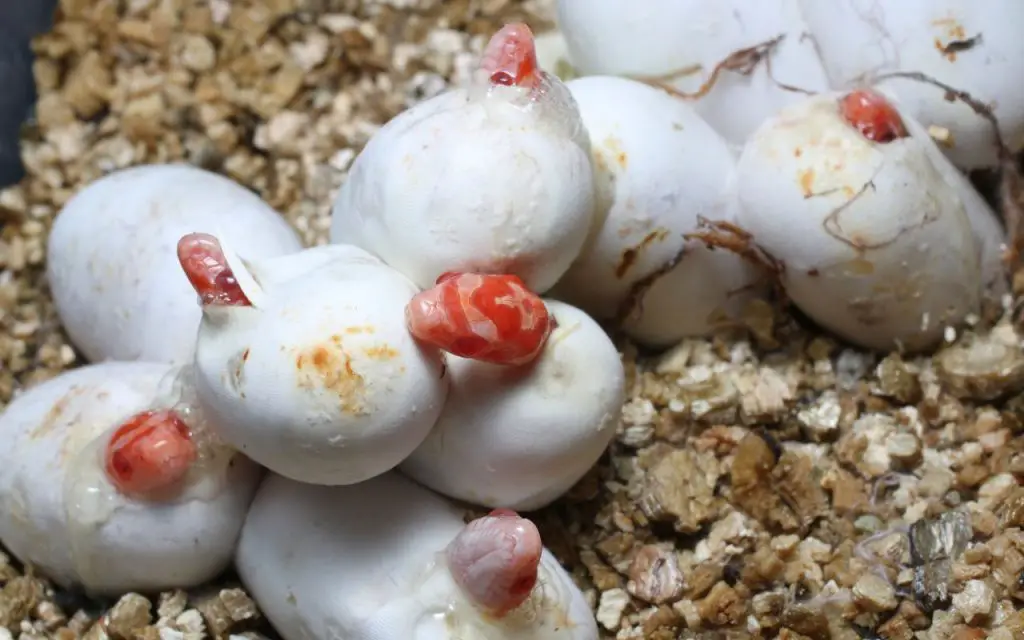Want to learn to distinguish lizard eggs vs snake eggs? Then’s let’s dive in! It’s not an exact science, but I can certainly give you a few pointers…
Last updated on February 1st, 2023 at 09:23 am
Lizard eggs are generally smaller and rounder than snake eggs. They also tend to be found in different locations. Eggs found above the ground are much more likely to be lizard eggs, as in geckos. Another key difference is that snake eggs almost always stick together, whereas the eggs of many lizard species do not.

How To Identify Snake Eggs?
There are many characteristics that set a snake’s egg apart from other eggs. The most important feature of snake eggs is that they are leathery, unlike bird eggs.
But the soft and tough shell is in fact a character of most reptile eggs. Further characteristics that distinguish a snake egg are shape and appearance.
The clutch of 2 to 50+ usually consists of elongated oval eggs. The colors of the eggs are usually white or off-white and do not have brown or black specks for camouflage.

What Do Lizard Eggs Look Like?
Lizard eggs are like all other reptile eggs. They also have a tough leathery shell and may be present in variable clutch sizes.
The only consistent difference from a snake egg is that lizard eggs are smaller. But there are some exceptions to this rule.
Another visible difference from snake eggs is that lizard eggs will often deviate from being oval to almost being spherical.
How To Tell If A Lizard Egg Is Alive?
Healthy eggs have a fetus growing inside them. So if you shine a light inside them, you should be able to see a few blood vessels developing.
Overall healthy eggs appear pink and red when a light is shined on them. But unhealthy eggs glow yellow as the yolk and albumen remain unaltered.
After several inspections over days, if an egg still glows yellow you can conclude that the egg is not fertilized. Such eggs turn yellow and start growing mold eventually.
What Do Snake Eggs Look Like?
Lizard eggs and snake eggs are very similar and quite tough to tell apart by how they look. Snake eggs do have some natural variability but the common features among them are as follows:
- Snake eggs are 1 to 5 inches long, larger than lizard eggs.
- They are usually more in number than lizard eggs. Large snakes can lay more than 50 eggs. Usually clutches have 10 to 30 eggs.
- Most snake eggs are oblong and elongated, but some are more oval. The skin of snake eggs can be bumpy.
- Snake eggs are white or beige or off-white. Colorful snake eggs may mean that the snakes inside them are dead.
- Snake eggs are soft and leathery, and often stick to each other.
How Big Are Snake Eggs?
As a general rule of thumb, snake eggs are much bigger than lizard eggs. But for all reptiles, the size of the adult is the deciding factor when it comes to the size of the egg.
So a Komodo Dragon egg will be much bigger than a small Corn Snake Egg (1 to 2-inch long eggs). But other than these exceptional cases lizard eggs are smaller, around 1 to 5 cm long.
Eggs laid by all snakes Are in the range of 1 to 5 inches long. The bigger snakes like Pythons have 4 to 5-inch long eggs to accommodate the much larger fetus.
Are Lizard Eggs Hard Or Soft?
Lizard eggs are much more variable than snake eggs. Although the most common lizard eggs have a tough and leathery shell, which herpetologists refer to as ‘parchment-shelled’ eggs.
They are usually placed in a dugout nest by the mother for their protection. But in some cases, lizard eggs contain minerals in the shell which harden upon getting in contact with the air.
When these eggshells harden, they can become more like bird’s eggs or crocodile eggs. For the most part, it’s various species of Geckos that have hard shells. A good example is the Tokay Gecko, whose eggs hardened after being laid and stick to surfaces like glue.
Another arboreal species, the Madagascar Giant Day Gecko, also lays eggs that harden over a period of days. In case you’re wondering, everyone’s favorite pet lizard, the Leopard Gecko, lays soft eggs.

How To Care For Lizard Eggs?
Although lizards are found all across the world in a range of habitats, most of the lizards kept as pets are tropical. So they are temperature sensitive.
This is especially true for their eggs, which have to be kept in a very narrow range of temperatures to induce hatching. In fact, the incubation temperature of lizards is even more critical as a lot of them show temperature dependent sex determination.
To get a batch of lizard eggs to hatch do the following:
- First you have to either locate the eggs laid by your lizard in her tank.
- Next, you have to choose the right size of container to incubate the eggs in. This depends on the size of the egg.
- Place it inside your incubator. The incubator should also be appropriately sized to house the clutch of eggs.
- Some people make a DIY incubator, but this is admittedly a little more complicated.
- Ensure that you use an accurate thermometer inside your incubator for the best result.
- Place the eggs inside the incubator and seal them. Protect it and maintain humidity and temperature till the eggs hatch.
Are Snake Eggs Round Or Oval?
Whereas lizard egg shapes can vary from oval to round, snake eggs are close to being oval. There is still some natural variation in the shape of snake eggs.
Most snakes’ eggs which deviate from the oval shape are not round. They are quite elongated compared to the round eggs of turtles.
So snake eggs as a whole are said to be ovoid, or close to being oval. They also have bumps in their shells, usually making them rough rather than smooth.

What To Do If You Find A Lizard Egg?
Most common lizard eggs have a tough but leathery shell. This makes their outer covering flexible and protects them from mechanical damage.
Lizard eggs require strict temperature and humidity to hatch. If you find a lizard egg in a nest, it is best to leave the eggs exactly as you found them.
This is because the nests naturally have well-regulated heat and moisture to allow the eggs to develop. If you cannot leave the egg where you found it, then you should place it in a container.
Try not to change its orientation too much during this process as it might damage the embryo. If you manage to shift the egg in a container, place it in a safe place at your home and try to acquire an incubator with an accurate thermometer.
Placing the egg in a good incubator and setting it to the correct temperature is the best bet to get the eggs to hatch. If you manage to do that, even slightly cracked eggs might produce hatchlings.

Lizard Eggs vs Snake Eggs: Summary
Let’s do a quick re-cap of the the main differences between snake and lizard eggs…
| Lizard Eggs | Snake Eggs |
| – may be leathery or, less commonly, hard-shelled | – are always leathery |
| – may be oblong, ovoid or spherical | – are generally oblong, and rarely spherical |
| – often number less than a ten in a clutch | – may number more than 20 in a clutch |
| – may be stuck to walls, or tree branches | – are almost always laid in rotten logs or vegetation |
| – are often 1inch (2.54cm) long or smaller | – usually over 1inch (2.54cm) long |
| – may or may not stick together | – almost always tick together |

FAQ Relating To Lizard Eggs Vs Snake Eggs
Are Snakes Eggs Hard Or Soft?
Snake eggs are usually leathery and soft. This prevents them from cracking when they are piled up in the clutch. It also lets new hatchlings easily break the eggshell and emerge when they are ready. Even the largest snakes do not produce hard-shelled eggs. The only downside to having soft shells is that they need more humidity to stay alive – many snake eggs require 80% humidity or higher.
What Color Are Snake eggs?
Snake eggs are usually white or off-white. They do not have any hue or venation. Since the eggs are buried by the mother they do not need camouflage. So they do not have colored specks of any sort as well. For some reason though, many colubrid eggs get brown marks on them a few days before hatching. Why this might be is unclear.
What Do Unfertilized Snake Eggs Look Like?
Unfertilized snake eggs glow yellow when a light is shined on them. This is because there are no developing embryos inside. Eventually, these eggs turn blue or green. This eventually leads to the formation of molds. Infertile snake eggs are referred to as “slugs” by hobbyists, and are pretty easy to identify. Even right after laying they look yellowish, waxy and rubbery.
What To Do If You Find Snake Eggs In Your Yard?
If you find snake eggs in your yard then leave them where you found them for the best chance of their survival. But if you want to raise them as pets you have to buy an incubator. You have to shift the eggs into the incubator inside a container and raise them in controlled conditions. Maintain temperature and humidity accurately to get the best result. Always remember that you mustn’t turn snake eggs upside down or it can kill them.
Key Takeaways
- Snake Eggs are usually soft and flexible, like most lizard eggs. But some lizards have eggs with hard shells.
- Most snakes have oval or close-to-oval eggs. Lizards have shapes that vary between oval and round across their various species.
- Snake eggs are usually larger and lizard eggs are usually smoother.

